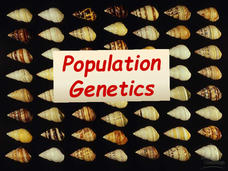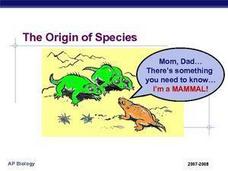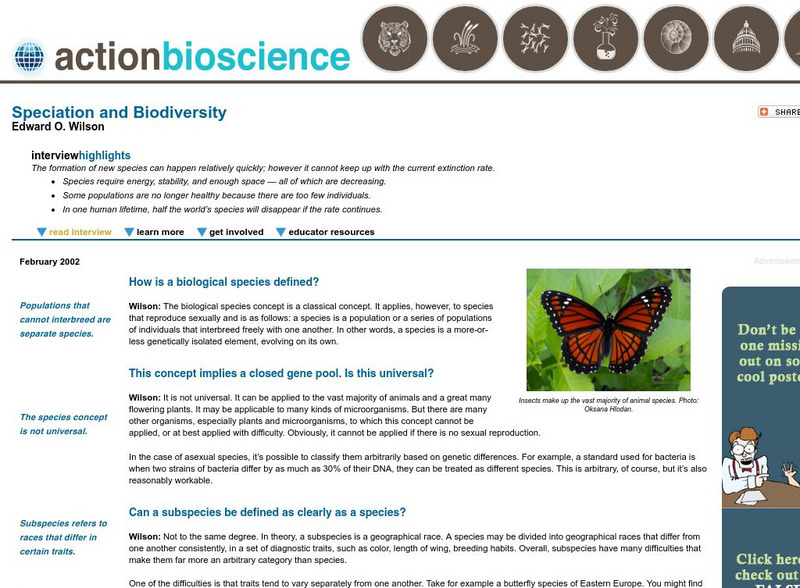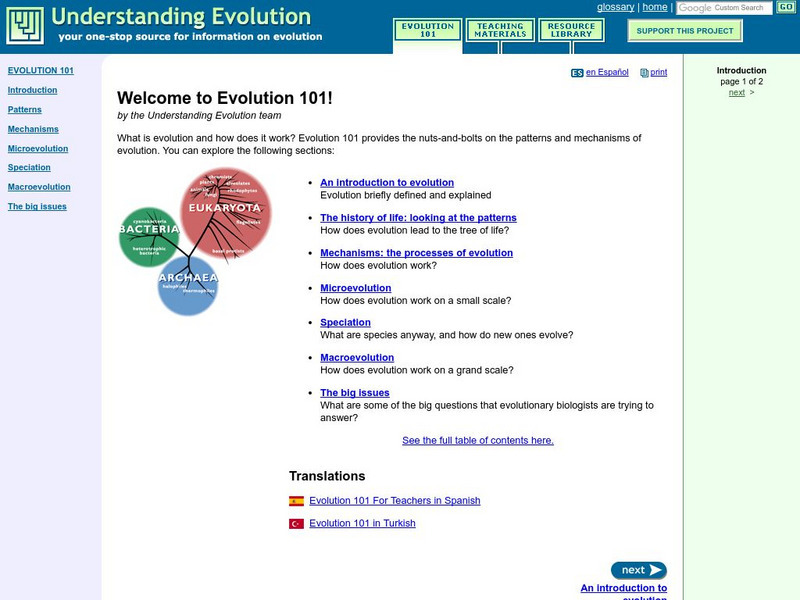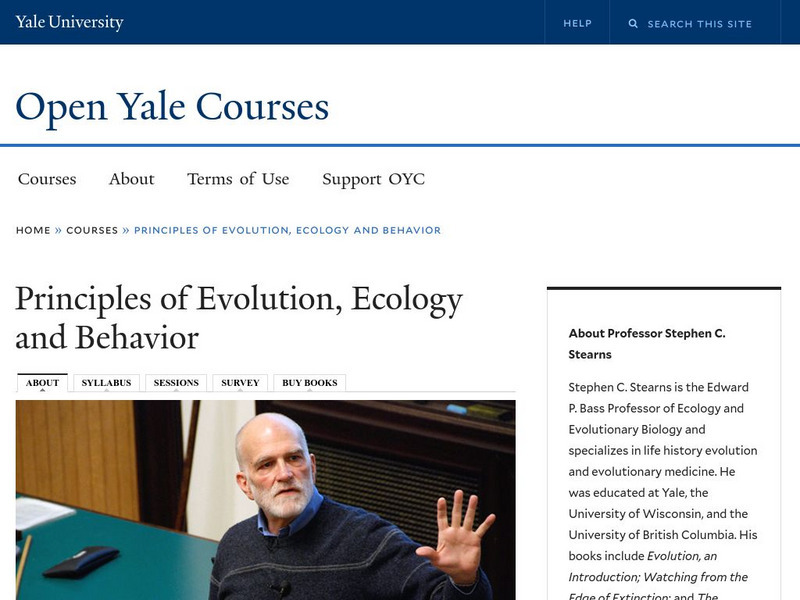College Board
2013 AP® Biology Free-Response Questions
AP® free-response questions are often challenging for scholars. Give them practice writing free-response questions using former questions from the AP® Biology exam on topics such as genetic mutations, cellular respiration, evolution, and...
Howard Hughes Medical Institute
Beaks as Tools: Selective Advantage in Changing Environments
How does nature select some adaptations over others? Scholars experiment picking up seeds with two different types of tools simulating beaks. After practicing, they experience a drought where one type of seed suddenly isn't available....
Howard Hughes Medical Institute
Evolution in Action: Data Analysis
An environmental factor, such as a drought, sometimes speeds up the rate of natural selection. Scholars analyze data on the beaks of birds around the time of the drought. They compare those that survived to those that perished and find...
Biology Junction
Population Genetics
Genetic variation shows the health of a population, yet cheetahs show very little variation over that last 10,000 years. Scholars learn the importance of genetic variation in populations after viewing an informative presentation. It...
Channel Islands Film
Island Rotation: Lesson Plan 4
Foster's Rule? Allopatric speciation? After watching West of the West's documentary Island Rotation, class members use Venn diagrams to compare endemic species on the Channel Islands with mainland related species. They then create a...
Curated OER
Chapter 23 Guided Notes: The Origin of Species
This doesn't have to be used as a guided notes worksheet because the questions are thought-provoking and applicable to any biology class that is learning about the origin of species. Pupils write out answers to questions about...
Curated OER
AP: Chapter 24: The Origin of Species
AP biology buffs define vocabulary terms and answer critical-thinking questions about evolutionary trends. They compare macroevolution to microevolution, differentiate ploidy possibilities, explain isolation barriers, and more....
Curated OER
Speciation and Genetic Drift Worksheet
Fifteen terms pertaining to speciation, extinction, and gene flow are to be matched to their definitions. This simple, easy-to-read worksheet can be used as a pop quiz for your biology learners when studying natural selection principles...
Curated OER
Origin of The Species
After viewing information about different types of isolation, students will see that reproduction among a group will cause the frequency of a specific trait to increase. The history of prominent scientists such as Charles Darwin are and...
Curated OER
Survivors on the Ocean Ridge
Students discover the uniqueness of deep sea hydrothermal vent organisms through an exploration of the NOAA Galapagos Rift Expedition. They study the genetics and evolution of a shrimp species that lives near the vents then they...
Curated OER
A STEP IN SPECIATION
Students place different subspecies of a CA salamander are placed on grid map of CA according to where samples were collected. Then discuss patterns of their distribution, their likely evolutionary relationships, and probable sequence of...
Curated OER
The Process of Speciation
Learners illustrate the results of natural selection by identifying conditions that could lead to the development of new species (speciation) based on a given description of environmental conditions and description of variation within a...
Curated OER
How Do New Species Form?
Students read an article by Niles Eldridge about species and the environment and break into small groups to discuss it. They write essays noting strengths and weaknesses of punctuated equilibrium and gradualism, or other topics listed.
Curated OER
Island Biogeography and Evolution
High schoolers develop likely phylogenies for seven related populations of lizards living on the Canary Islands using real data. They organize charts, and record the data for geography, geology, morphology, and molecular genetics.
Curated OER
Anolis Lizards of the Greater Antilles
Students "take a trip" to the Greater Antilles to observethe Anolis lizards. They study the body structures and habitat of different species, then plot this data on a map to look for patterns in their distribution. From the patterns they...
Concord Consortium
Concord Consortium: Stem Resources: Natural Selection
Build a dam in the middle of an ecosystem and observe how the population of plants and animals adapt to their new environment with this science simulation. Learn how the populations adapt to survive in their new habitat. Then remove the...
PBS
Pbs Learning Media: Chris Schneider: Rethinking Conservation
In this interview filmed for Evolution: "Darwin's Dangerous Idea," biologist Chris Schneider discusses the relationship between conservation and speciation.
TED Talks
Ted: Ted Ed: Five Fingers of Evolution
Video discusses the concept of evolution and the five processes that can cause it to happen. [5:24] Includes a brief quiz and a list of additional resources to explore.
American Institute of Biological Sciences
Action Bioscience: Speciation and Biodiversity
Dr. E.O. Wilson, known internationally as the dean of biodiversity, answers several probing questions about speciation and biodiversity.
Encyclopedia of Earth
Encyclopedia of Earth: Evolutionary Biology: Evolution in Action
Scientific article discussing the evolutionary processes involved when an insect species splits into two other distinct species. (Published: February 28, 2011)
Other
Clermont College: Natural Selection and Speciation
Discusses natural selection and explains this theory in detail in reference to the evolution of the peppered moth. Discusses how the forces of natural selection lead to other kinds of speciation and evolutionary processes.
University of California
University of California Museum of Paleontology: Welcome to Evolution 101
What is evolution? This thorough site provides the basics of evolution focusing on the history of life, processes of evolution, microevolution, macroevolution, and more.
CK-12 Foundation
Ck 12: Episd: Origin of Species
[Free Registration/Login may be required to access all resource tools.] Study the process of speciation and two types: allopatric and sympatric presented in this module.
Yale University
Open Yale Courses: Principles of Evolution, Ecology, and Behavior
Access any one of thirty-six lectures from a biological sciences course, in audio, video, and text format. Coverage includes evolution, natural selection, the fossil record, the history of life on Earth, ecological communities,...




